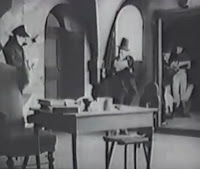Golem-blogging, essay 19 of 21
 |
| Ernst Deutsch as Famulus in The Golem (1920). |
The Famulus
Before beginning these Golem
essays, I was unaware of the word “famulus.” I assumed it was just the
servant’s name—not a job description. But it is a word as well as a name, and
that’s why some critical writings on
The Golem (1920) refer to “the
famulus” as opposed to his proper name in the movie, Famulus. And a famulus is defined
as a private secretary or attendant, usually the assistant to a scholar or a
magician.
In
The Golem, this particular famulus
is named Famulus.
 |
Blissful in Miriam's bedroom before the Golem
comes knocking. |
Famulus ends up with the heroine, so if this is a textbook fairy tale, we might
assume that he is the hero. I am deeply uncomfortable with this reading of the
movie, and love the movie’s ambiguous presentation of Famulus. As I’ve
mentioned before, the stock identities, hero and heroine and villain, are very
fluid in
The Golem. Florian acts mildly villainous throughout, but in
his final moments, he shows some heroism, attacking the Golem with a knife in
an effort to protect Miriam as much as himself. And he is the victim in this
scene, in a movie that always identifies with the victim. He sleeps with the
heroine, but I don’t see any visual condemnation of their tryst. They both look
pretty blissful in the pre-Raphaelite setting of Miriam's bedroom.
When Famulus discovers that Florian is in Miriam’s bedroom, his jealousy
becomes palpable and he swiftly changes tactics, rushing off to reanimate the
Golem. From the standpoint of both plot and images, Famulus is now the villain
and Florian and Miriam are the sympathetic characters. It could conceivably be
argued that Famulus is only the villain to the extent that Mickey Mouse is the
villain in “The Sorcerer’s Apprentice” segment in
Fantasia (and the
parallels are considerable, with the sorcerer in Disney’s movie even moving
much like Rabbi Loew when he summons magical forces). But Mickey is sympathetic
because his motivation is a very innocent curiosity and ambition; it is much
harder to sympathize with a jealous character in a love triangle.
 |
| Jealous Famulus; angry Golem. |
Famulus triggers the Golem’s rage when he restores the clay to life. Famulus’
jealous renders him indirectly responsible for Florian’s death. Furthermore,
Famulus becomes indirectly responsible for the fire that spreads through the
ghetto, destroying the Rabbi’s house. He has a lot to answer for.
 |
Miriam, draped across a rock
by the Golem. |
 |
Julie Adams draped across a rock
in The Creature from the Black
Lagoon (1954). |
In his last scene, Famulus has a private moment with Miriam. She has been
abandoned by the monster, draped across a rock in a time-honored horror
tradition that would later memorably include Julie Adams in
The Creature
from the Black Lagoon and many others. Famulus asks her: “Can you forgive?”
Then he says that all evidence of Florian will be lost in the fire, and that he
will never tell.
 |
Famulus and Miriam, a couple
with secrets. |
My response is: Beware of this relationship, Miriam. You are setting yourself
up for a lifetime of blackmail. Forgive him if you want, but then walk away.
Quickly.
But the movie ends with the implication that Miriam takes the bait. I don’t see
this as a “happily ever after” ending at all. It’s intelligently and pleasantly
complex, leaving you with that sour, uneasy feeling that you sometimes get from
the best of Hitchcock.
A side note: The actor playing Famulus is Ernst Deutsch. He's okay in the part,
often playing very broadly but no worse than the other actors around him
(excepting Wegener's magnificent performance). Deutsch went on to a very
successful career as a film actor, eventually moving to
Hollywood where he played Nazis, doctors, and
decadent aristocrats. If
The Golem wasn't enough to ensure him of screen
immortality, he can also claim a memorable performance as Baron Kurtz in
another of my all-time favorite movies,
The Third Man (1949).
 |
| Ernst Deutsch, 29 years later, as Baron Kurtz in The Third Man (1949). |
Watch
The Golem (1920):
Purchase through
Kino International
or at
Amazon,
rent through Netflix,
or sneak a peek at YouTube.
© 2011 Lee Price





















































